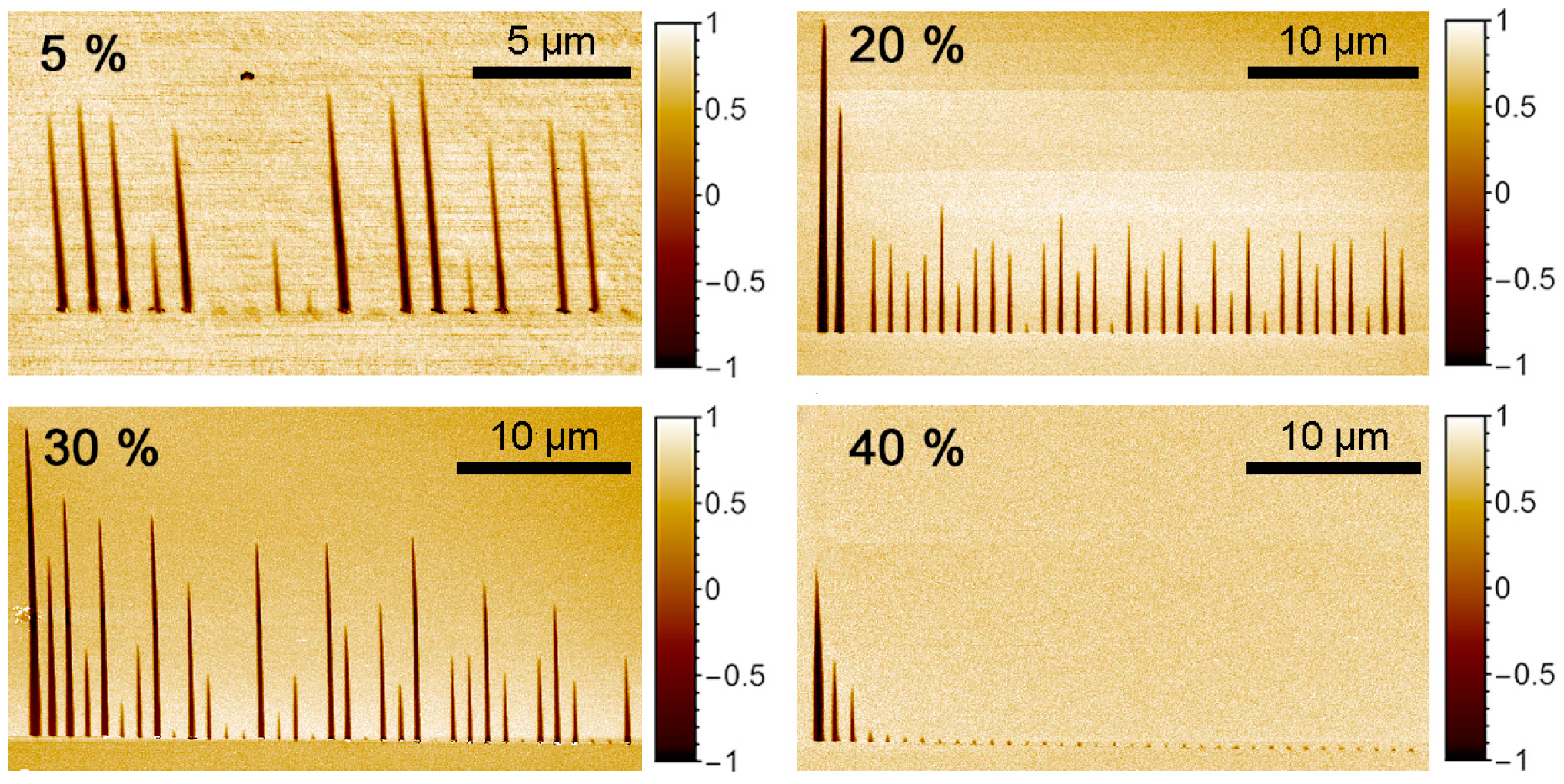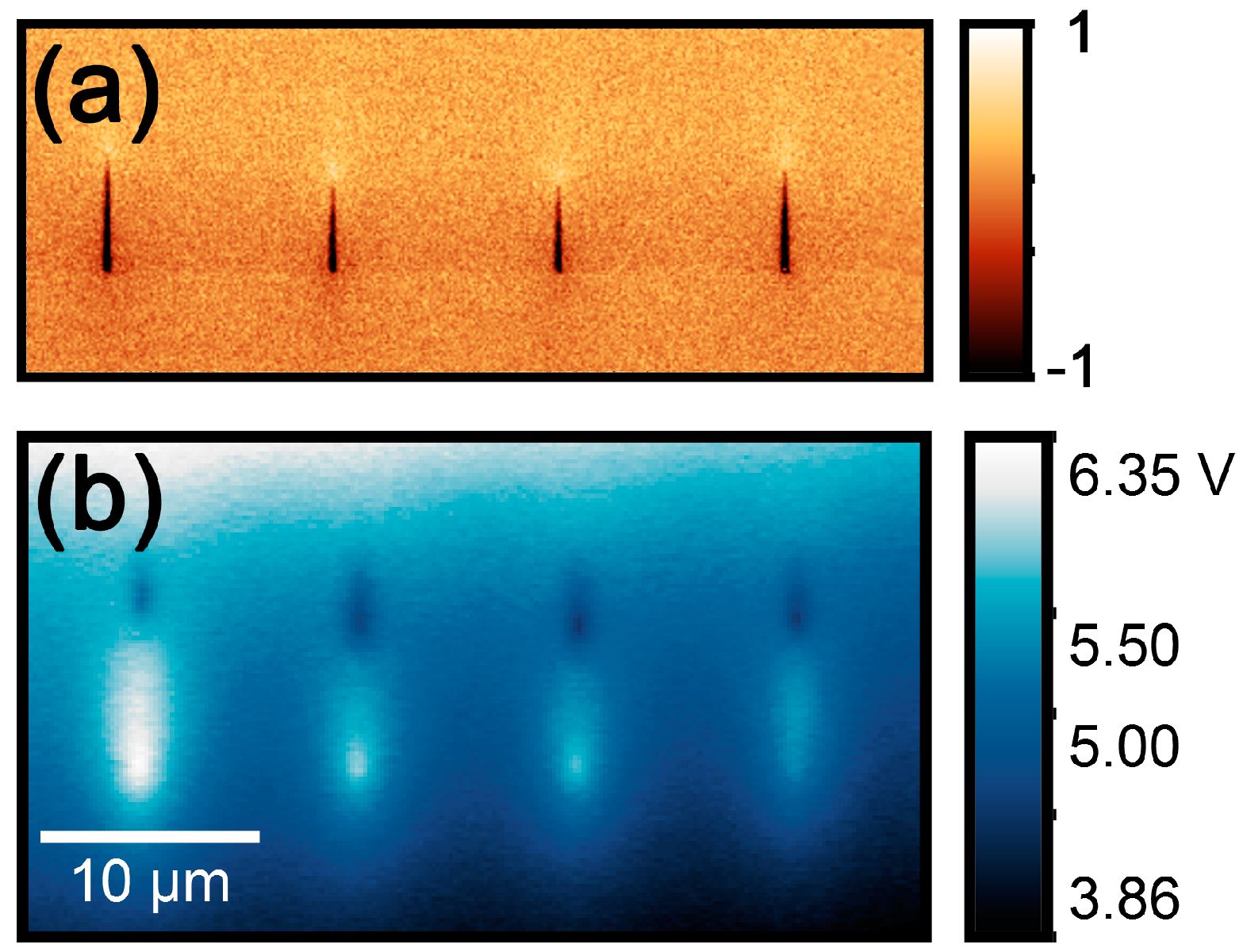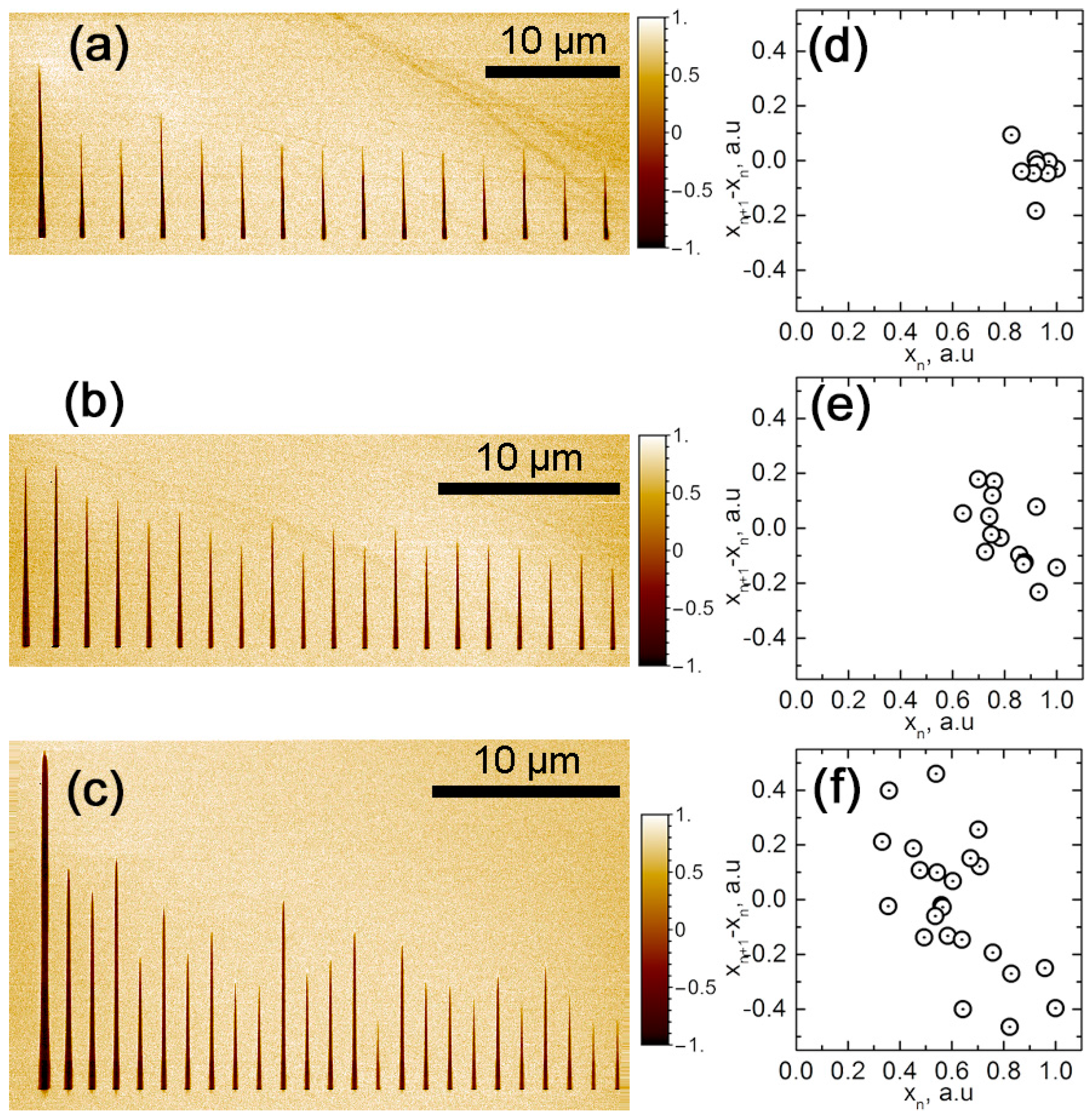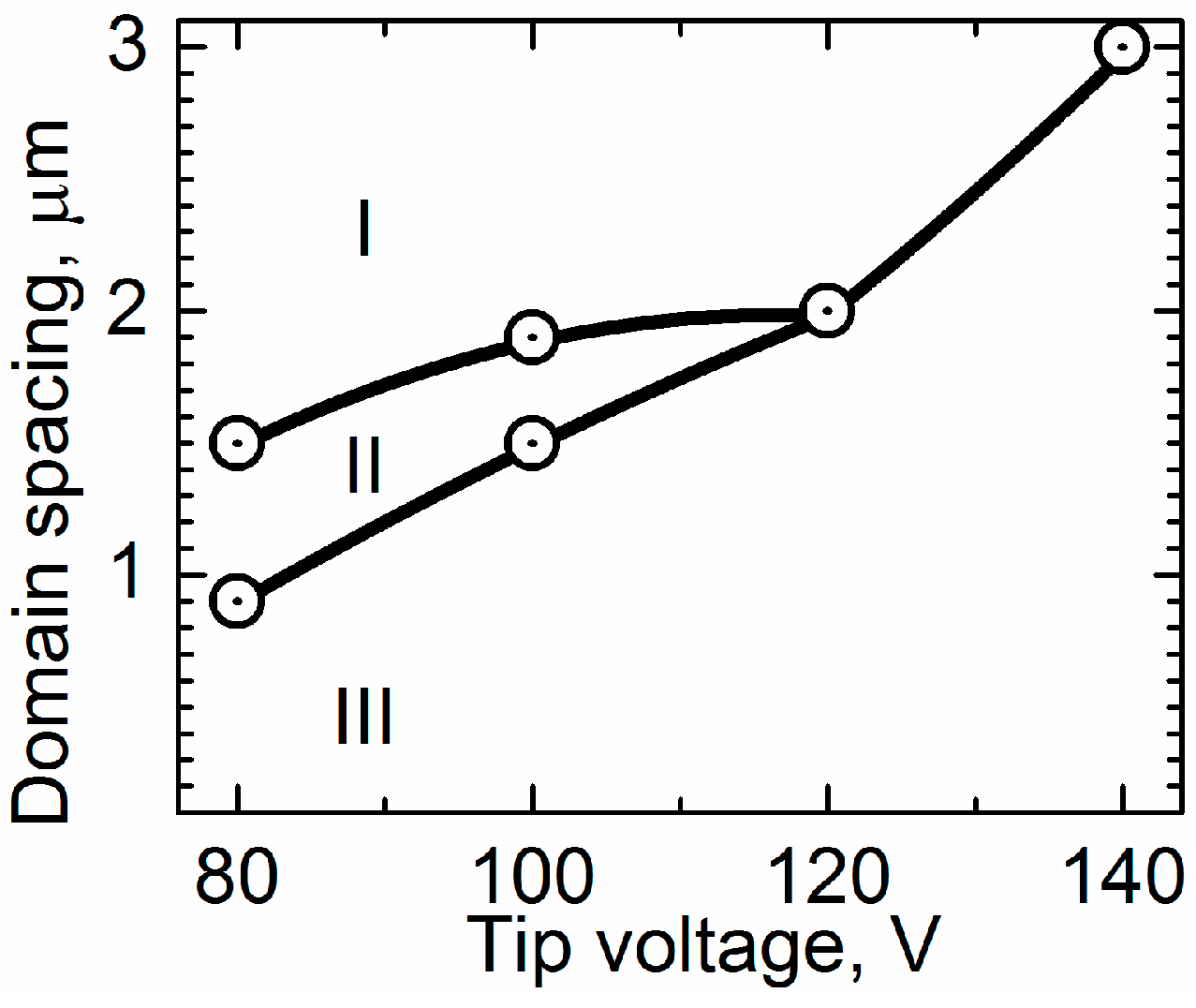The Formation of Self-Organized Domain Structures at Non-Polar Cuts of Lithium Niobate as a Result of Local Switching by an SPM Tip
Abstract
:1. Introduction
2. Materials and Methods
3. Results and Discussion
4. Conclusions
Acknowledgments
Author Contributions
Conflicts of Interest
References
- Güthner, P.; Dransfeld, K. Local poling of ferroelectric polymers by scanning force microscopy. Appl. Phys. Lett. 1992, 61, 1137–1139. [Google Scholar] [CrossRef]
- Kolosov, O.; Gruverman, A.; Hatano, J.; Takahashi, K.; Tokumoto, H. Nanoscale visualization and control of ferroelectric domains by atomic force microscopy. Phys. Rev. Lett. 1995, 74, 4309–4312. [Google Scholar] [CrossRef] [PubMed]
- Rodriguez, B.J.; Nemanich, R.J.; Kingon, A.; Gruverman, A.; Kalinin, S.V.; Terabe, K.; Liu, X.Y.; Kitamura, K. Domain growth kinetics in lithium niobate single crystals studied by piezoresponse force microscopy. Appl. Phys. Lett. 2005, 86, 012906. [Google Scholar] [CrossRef]
- Terabe, K.; Nakamura, M.; Takekawa, S.; Kitamura, K. Microscale to nanoscale ferroelectric domain and surface engineering of a near-stoichiometric LiNbO3 crystal. Appl. Phys. Lett. 2004, 82, 433–435. [Google Scholar] [CrossRef]
- Rosenman, G.; Urenski, P.; Agronin, A.; Rosenwaks, Y.; Molotskii, M. Submicron ferroelectric domain structures tailored by high-voltage scanning probe microscopy. Appl. Phys. Lett. 2003, 82, 103–105. [Google Scholar] [CrossRef]
- Eng, L.M.; Abplanalp, M.; Günter, P.; Güntherodt, H.J. Nanoscale domain switching and 3-dimensional mapping of ferroelectric domains by scanning force microscopy. J. Phys. IV Fr. 1998, 8, Pr9-201–Pr9-204. [Google Scholar] [CrossRef]
- Abplanalp, M.; Fousek, J.; Günter, P. Higher order ferroic switching induced by scanning force microscopy. Phys. Rev. Lett. 2001, 86, 5799–5802. [Google Scholar] [CrossRef] [PubMed]
- Tybell, T.; Paruch, P.; Giamarchi, T.; Triscone, J. Domain wall creep in epitaxial ferroelectric PbZr0.2Ti0.8O3 thin films. Phys. Rev. Lett. 2002, 89, 097601. [Google Scholar] [CrossRef] [PubMed]
- Shvartsman, V.V.; Kleemann, W.; Haumont, R.; Kreisel, J. Large bulk polarization and regular domain structure in ceramic BiFeO3. Appl. Phys. Lett. 2007, 90, 172115. [Google Scholar] [CrossRef]
- Alikin, D.O.; Turygin, A.P.; Walker, J.; Bencan, A.; Malic, B.; Rojac, T.; Shur, V.Ya.; Kholkin, A.L. The effect of phase assemblages, grain boundaries and domain structure on the local switching behavior of rare-earth modified bismuth ferrite ceramics. Acta Mater. 2017, 125, 265–273. [Google Scholar] [CrossRef]
- Lilienblum, M.; Soergel, E. Anomalous domain inversion in LiNbO3 single crystals investigated by scanning probe microscopy. J. Appl. Phys. 2011, 110, 052018. [Google Scholar] [CrossRef]
- Shur, V.Ya.; Ievlev, A.V.; Nikolaeva, E.V.; Shishkin, E.I.; Neradovskiy, M.M. Influence of adsorbed surface layer on domain growth in the field produced by conductive tip of scanning probe microscope in lithium niobate. J. Appl. Phys. 2011, 110, 052017. [Google Scholar] [CrossRef]
- Ievlev, A.V.; Jesse, S.; Morozovska, A.N.; Strelcov, E.; Eliseev, E.A.; Pershin, Yu.V.; Kumar, A.; Shur, V.Ya.; Kalinin, S.V. Intermittency, quasiperiodicity and chaos in probe-induced ferroelectric domain switching. Nat. Phys. 2013, 10, 59–66. [Google Scholar] [CrossRef]
- Shur, V.Ya.; Gruverman, A.L.; Rumyantsev, E.L. Dynamics of domain structure in uniaxial ferroelectrics. Ferroelectrics 1990, 111, 123–131. [Google Scholar] [CrossRef]
- Shur, V.Ya. Kinetics of ferroelectric domains: Application of general approach to LiNbO3 and LiTaO3. J. Mater. Sci. 2006, 1, 199–210. [Google Scholar] [CrossRef]
- Ievlev, A.V.; Alikin, D.O.; Morozovska, A.N.; Varenyk, O.V.; Eliseev, E.A.; Kholkin, A.L.; Shur, V.Ya.; Kalinin, S.V. Symmetry breaking and electrical frustration during tip-induced polarization switching in the nonpolar cut of lithium niobate single crystals. ACS Nano 2015, 9, 769–777. [Google Scholar] [CrossRef] [PubMed]
- Alikin, D.O.; Ievlev, A.V.; Turygin, A.P.; Lobov, A.I.; Kalinin, S.V.; Shur, V.Ya. Tip-induced domain growth on the non-polar cuts of lithium niobate single crystals. Appl. Phys. Lett. 2015, 106, 182902. [Google Scholar] [CrossRef]
- Shur, V.Ya.; Gruverman, A.L.; Ponomarev, N.Y.; Rumyantsev, E.L.; Tonkacheva, N.A. Domain structure kinetics in ultrafast polarization switching in lead germanate. JETP Lett. 1991, 53, 615–619. [Google Scholar]
- Shur, V.Ya. Correlated Nucleation and Self-Organized Kinetics of Ferroelectric Domains. In Nucleation Theory and Applications; Schmelzer, J.W.P., Ed.; Wiley-VCH Verlag GmbH & Co. KGaA: Weinheim, Germany, 2005; pp. 178–214. ISBN 9783527604791. [Google Scholar]
- Shur, V.Ya.; Chezganov, D.S.; Nebogatikov, M.S.; Baturin, I.S.; Neradovskiy, M.M. Formation of dendrite domain structures in stoichiometric lithium niobate at elevated temperatures. J. Appl. Phys. 2012, 112, 104113. [Google Scholar] [CrossRef]
- Shur, V.Ya.; Akhmatkhanov, A.R.; Baturin, I.S. Micro- and nano-domain engineering in lithium niobate. Appl. Phys. Rev. 2015, 2, 040604. [Google Scholar] [CrossRef]
- Shur, V.Ya.; Rumyantsev, E.L.; Nikolaeva, E.V.; Shishkin, E.I.; Fursov, D.V.; Batchko, R.G.; Eyres, L.A.; Fejer, M.M.; Byer, R.L. Nanoscale backswitched domain patterning in lithium niobate. Appl. Phys. Lett. 2000, 76, 143–145. [Google Scholar] [CrossRef]




© 2017 by the authors. Licensee MDPI, Basel, Switzerland. This article is an open access article distributed under the terms and conditions of the Creative Commons Attribution (CC BY) license (http://creativecommons.org/licenses/by/4.0/).
Share and Cite
Turygin, A.; Alikin, D.; Alikin, Y.; Shur, V. The Formation of Self-Organized Domain Structures at Non-Polar Cuts of Lithium Niobate as a Result of Local Switching by an SPM Tip. Materials 2017, 10, 1143. https://doi.org/10.3390/ma10101143
Turygin A, Alikin D, Alikin Y, Shur V. The Formation of Self-Organized Domain Structures at Non-Polar Cuts of Lithium Niobate as a Result of Local Switching by an SPM Tip. Materials. 2017; 10(10):1143. https://doi.org/10.3390/ma10101143
Chicago/Turabian StyleTurygin, Anton, Denis Alikin, Yury Alikin, and Vladimir Shur. 2017. "The Formation of Self-Organized Domain Structures at Non-Polar Cuts of Lithium Niobate as a Result of Local Switching by an SPM Tip" Materials 10, no. 10: 1143. https://doi.org/10.3390/ma10101143





